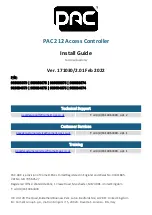
6.2. MAINTENANCE OF THE ELECTROLYSIS CELL
The electrolysis cell must be kept in suitable conditions to ensure a long lifetime. This salt
chlorination unit has an automatic electrode cleaning system that helps to prevent scale build-
up on the electrode surface. If the salt chlorination system is operated in accordance with
these instructions, and in particular if the pool water balance is kept within the recommended
parameters, it should not be necessary to manually clean the electrodes. However, if the
pool water and the salt chlorination system are not maintained in line with these instructions
then it may be necessary to manually clean the electrodes following the procedure outlined
below:
o
Disconnect the 220 Vac supply of the equipment.
o
Disconnect the supply cable of the electrodes
o
Unscrew the closing nut (see section 3.3-2) located at the end where the electrodes
are located, and remove the electrode package.
o
Use diluted hydrochloric acid (a part of commercial acid in 10 parts of water),
submerging the electrode package in the prepared solution for no more than 10
minutes
o
NEVER SCRAPE OR SWEEP THE CELL OR THE ELECTRODES.
The electrodes of a salt chlorination system comprise of a titanium sheet coated with a layer
of noble metal oxides. The electrolysis processes that take place on their surface produce a
progressive wearing down – the electrodes do have a finite life. In order to optimise electrode
lifetime, please consider the following:
o
Although all IDEGIS salt electrolysis units are SELF-CLEANING, a prolonged
operation of the system at pH values over 7.6 in waters of high hardness can produce
scale formation on the surface of the electrodes. Scaling on the electrodes surface will
progressively deteriorate the coating, causing a decrease of lifetime.
o
Manually cleaning/washing the electrodes (as described above) will shorten their life.
o
Prolonged operation of the system at salinities lower than 3 g/l (3000 ppm) will cause a
premature deterioration of the electrodes.
o
Frequent use of copper based algaecides will promote the formation of copper
deposits on the electrodes, progressively damaging the coating.
6.3. SALT ADDITIONS
If “LOW SALT” message appears on system display, it is necessary to add salt to the pool.
For a suitable salinity control, we recommend using a Conductivity/TDS portable meter , or
another similar device, whenever the electrodes are in good state. The type of common salt
(NaCl) recommended for salt electrolysis systems must not have any additive (iodides, etc.)
and must be apt for human consumption.
30
Содержание D-10+
Страница 1: ...SALT ELECTROLYSIS SYSTEM D 10 EN D 18 D 25 D 40 integrated pH ORP controller OPERATION MANUAL D 40...
Страница 2: ......
Страница 4: ...7 PRACTICAL ADVICES 8 TROUBLESHOOTING 9 WARRANTY 35 36 38 2...
Страница 9: ...7...
Страница 23: ...5 1 3 RUN ORP CONTROL NOT ACTIVATED MANUAL MODE 21...
Страница 24: ...ORP CONTROL ACTIVATED AUTOMATIC MODE 22...
Страница 41: ...NOTES...
Страница 42: ...NOTES...
Страница 43: ......













































